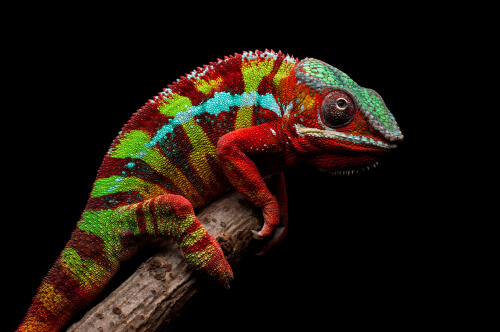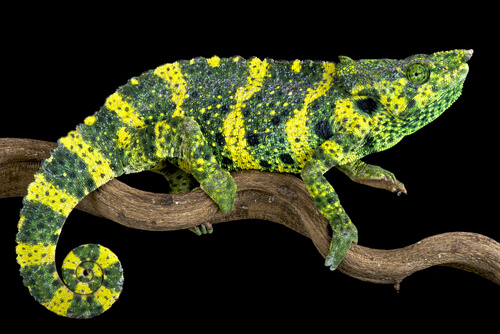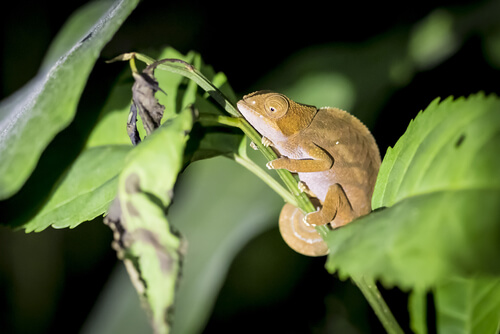9 Types of Chameleons That Make Great Pets
This page contains affiliate links. We may earn money or products from the companies mentioned in this post through our independently chosen links, which earn us a commission. Learn More

When you think of the chameleon, you picture a reptile that has the ability to change color with its surroundings. While all chameleons have the ability to change color to some extent, certain types of chameleons can more than others. Color-changing ability aside, chameleons are unique pets, to be sure.
If you’re considering a chameleon as a pet, it’s important to do your research. Chameleons have specific requirements in terms of habitat and diet, so you need to be sure you’re prepared to do the work to keep your new pet healthy.
To help you get started in your research, we’ve created a list of the 9 most popular types of chameleon. Take the time to learn a little about each type before deciding which one is right for you.
9 Types of Chameleons
Chameleons belong to the family Chamaeleonidae and are a group of just over 200 Old World lizards. These reptiles are known for their ability to change color but have a variety of other unique features as well. Chameleons have zygodactylous feet, extrudable tongues, and prehensile tails.
Here’s an overview of some of the most popular chameleon species:
1. Veiled Chameleon (Chamaeleo calyptratus)

- Origin: Yemen, Saudi Arabia
- Price: $40 to $250
- Size: Up to 24 inches
- Color: Green with yellow mottling
Perhaps the most popular pet chameleon species, the veiled chameleon is native to Yemen and Saudi Arabia. These chameleons grow up to 24 inches long from tail to nose, but females tend to be a little shorter in length (up to 14 inches) but thicker in body. Veiled chameleons have a large casque on their heads and they are typically pale green in color with yellow or tan mottling.
This type of chameleon is popular in the pet trade because they are easy to breed and prolific in egg production. They also tend to tolerate a wide range of conditions and adapt well to captive life.
2. Jackson’s (Three Horned) Chameleon (Trioceros jacksonii)

- Origin: East Africa
- Price: $75 to $175
- Size: Up to 13 inches
- Color: Bright green
This type of chameleon is native to East Africa but has been introduced in several United States including Hawaii, Florida, and California. Jackson’s chameleon is also known as the three-horned chameleon because males of the species grow three horns from their heads.
This species of chameleon comes in three subspecies, including the dwarf Jackson’s chameleon. The primary species grows to about 13 inches long and has an average lifespan around 8 years which is fairly long for a chameleon. Jackson’s chameleons are bright green in color with traces of blue and yellow.
3. Panther Chameleon (Furcifer pardalis)

- Origin: Madagascar
- Price: $100 to $500
- Size: Up to 8 inches
- Color: Red, green, or orange
First discovered in 1829, the panther chameleon is native to Madagascar where it can be found living in tropical forests. These chameleons are fairly small with males growing only about 8 inches in length. Coloration varies by geographic region, though most species exhibit red, orange, or green coloration.
The panther chameleon has a very long extrudable tongue – it can be even longer than the reptile’s body. These reptiles feed primarily on insects and they have a fairly short lifespan. Panther chameleons can also be quite territorial and are generally not the best species for handling.
4. Senegal Chameleon

- Origin: West Africa
- Price: $40
- Size: 6 to 8 inches
- Color: Bright green
Another type of chameleon that can be challenging to keep in captivity is the Senegal chameleon. These reptiles typically live 5 years or less and can be very sensitive to changes in their environment. As you might expect from the name, these chameleons are native to parts of West Africa including Senegal.
The Senegal chameleon lives in the moist savannah and typically comes in an olive brown coloration. In terms of sexual dimorphism, males of the species tend to be a little smaller than females. The average size for this chameleon is only about 6 to 8 inches.
5. Carpet Chameleon (Furcifer lateralis)

- Origin: Madagascar
- Price: $200
- Size: Up to 10 inches
- Color: Green, white bands
Also known as the white-lined chameleon, the carpet chameleon is another species endemic to Madagascar. These chameleons grow up to 10 inches in length. Males of the species tend to be a little larger and primarily green in color while females are wider in body and have a larger range of colors.
Carpet chameleons change color according to their mood and environment, though they primarily stick to a dark color during the day to absorb the warmth from the sun. These are some of the smallest pet chameleons and they are more timid than some species.
6. Fischer’s Chameleon (Kinyongia fischeri)

- Origin: Tanzania
- Price: $75 to $200
- Size: Up to 15 inches
- Color: Bright green
Named in honor of German herpetologist Johann Gustav Fischer, this chameleon is endemic to Tanzania. Fischer’s chameleon is easy to distinguish by bone protuberances that grow on the front of its face. This species is fairly large, growing up to 15 inches long.
Fischer’s chameleon is bright green in color and is one of the more popular species in the pet trade. These chameleons are hardy in captivity, provided they get adequate full-spectrum UVB lighting and an appropriate diet. They are primarily insectivorous in the wild and should be fed a similar diet in captivity.
7. Meller’s Chameleon

- Origin: East Africa
- Price: $100 to $200
- Size: Up to 24 inches
- Color: Green with yellow stripes
Sometimes called the giant one-horned chameleon, Meller’s chameleon is the largest species of chameleon that isn’t native to Madagascar. Found in the interior mountains and savannahs of East Africa, this species can also be found in Malawi, Tanzania, and Mozambique.
Meller’s chameleon grows up to 24 inches on average, though species up to 30 inches have been reported. These chameleons are green in color with white stripes and have a stubby nose-like growth just above the mouth. This species is very aggressive and doesn’t do well with other reptiles.
8. Outstalet’s Chameleon (Furcifer oustaleti)

- Origin: Magadascar
- Price: $60 to $200
- Size: Up to 27 inches
- Color: Grey
Also known as the Malagasy giant chameleon, this is one of the largest chameleon species growing up to 2 feet long. Oustalet’s chameleons are typically grey in color with light banding along the body. These chameleons are endemic to Madagascar where they can be found in a wide range of habitats, though they are fairly rare in primary forest.
In addition to large insects, Oustalet’s chameleon feeds on invertebrates as well as some smaller vertebrates like birds and other reptiles. This is also one of several chameleon species known to eat fruit. While chameleons use their tongues to catch prey, fruit is usually seized directly with the jaws.
9. Four-Horned Chameleon (Trioceros quadricornis)

- Origin: Cameroon
- Price: $200
- Size: 10 to 14 inches
- Color: Green, blue/purple accents
What makes the four-horned chameleon distinctive is, of course, its four horns, but these chameleons also have an elongated beard that makes them easy to distinguish. Also known as the Cameroon chameleon, this species grows up to 14 inches long and can be found in the rainforest of Cameroon.
Four-horned chameleons are typically green in color, often with blue or purple accent colors and have a unique sailfin running down the back of its body.
The Benefits of Owning a Chameleon
Chameleons are unique and amazing creatures, but they can be challenging to care for. While some species like the veiled chameleon are fairly adaptable, others are very sensitive to changes in their environment. Consider as well that chameleons can be aggressive, depending on the species, and most need to be kept alone or in a breeding pair.
What makes chameleons such great pets is that they are incredibly unique and interesting. Few other pets have the ability to change color and chameleons have a variety of other anatomical features that make them unlike any other pet.
In addition to being unlike any other pet you’ve ever owned; chameleons are actually simple to keep once you get their habitat setup. Chameleons do require a warm and humid environment set up to accommodate their arboreal lifestyle, but they are fairly low-energy pets and don’t require much attention or interaction. Chameleons are very quiet pets and, aside from the size of their terrarium, they don’t take up a lot of space.
What to Know Before Getting a Chameleon
Before bringing home a new pet, it’s important to do your research to understand what you’re getting into. Start by learning the basics about chameleons including their habitat and dietary requirements then move into the specifics for the particular species you hope to keep.
Here are some of the most important things to consider for pet chameleons:
- Different types of chameleons have different personalities – some can be very aggressive toward other reptiles while some species are very shy and timid.
- Chameleons are arboreal creatures, for the most part, so they require a habitat that provides vertical space and plenty of branches and vines for climbing.
- Most chameleons are insectivorous by nature, so you’ll need to provide a varied diet of insects – be sure to gut-load the insects as well for maximum nutritional value.
- Chameleons require both UVA and UVB light to help their bodies convert vitamin D into calcium – they need about 10 to 12 hours of full-spectrum light per day.
- Though chameleons have the ability to change color, these changes are often correlated with mood rather than their environment – learning to interpret your chameleon’s color is important.
- Because they are reptiles, chameleons rely on the ambient temperature of their environment to regulate their body temperature – you’ll need to provide several basking areas.
- Chameleons do not drink from water dishes, they get their water from droplets on leaves – you’ll need to install a dripper or a misting system in your chameleon enclosure.
Being a pet owner isn’t cheap, but chameleons are particularly pricey. The cost to keep a chameleon can be considerable because these reptiles have specific requirements for heat, humidity, and lighting as well as diet.
Fortunately, once you cover the cost to set up the terrarium your maintenance costs will be much lower. The biggest ongoing expenses are for food.
If you’re looking for a unique pet that will challenge your skills as a pet owner and give you an opportunity to learn, the chameleon may well be one to consider. Take what you’ve learned here to decide which type of chameleon is best for you.








